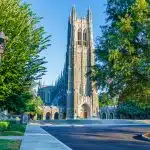Washington University in St. Louis (WashU) has already welcomed its Class of 2029, but it has yet to release official acceptance rate data. That said, considering recent trends, the numbers likely align with—or fall just below—WashU’s acceptance rate of 12.1% for the Class of 2028. In short, getting into WashU is tough.
Still, tough doesn’t mean impossible. If you put together a strong, well-crafted application, you just might find yourself opening that dream acceptance email from WashU. In this blog, we break down WashU’s acceptance rates for Early Decision, Regular Decision, transfer, and waitlist applicants and what these numbers mean for your chances of getting in.
- What is WashU’s Acceptance Rate?
- WashU Acceptance Rate Trends
- WashU Regular Decision Acceptance Rate
- WashU Early Decision Acceptance Rate
- How to Get Accepted into WashU
- WashU Transfer Acceptance Rate
- WashU Waitlist Acceptance Rate
- Frequently Asked Questions
- Takeaways
What is WashU’s Acceptance Rate?
For the Class of 2028, WashU’s acceptance rate was 12.1%. That’s only 3,951 out of a whopping 32,754 applications. Looking closer, how you choose to apply can change your chances:
| Application Type | Total Applications | Total Accepted | Acceptance Rate |
| Early Decision | TBA | TBA | 25.0% |
| Regular Decision | TBA | TBA | 8% |
| Total | 32,754 | 3,951 | 12.1% |
WashU hasn’t shared the exact number of students admitted through each option, but they did release the acceptance rates. Early Decision gave applicants a much better shot at 25%, while Regular Decision was far more competitive at just 8%.
If you’re considering Early Decision, keep in mind that it’s binding. That means you have to be 100% sure WashU is your top choice before hitting that submit button.
WashU yield rate
WashU’s yield rate for the Class of 2028 was 46.8%, meaning that out of the 3,951 students who were accepted, 1,848 chose to enroll.
Yield rate is the percentage of admitted students who actually decide to attend a school. It’s an important metric because it shows how desirable a university is among applicants. A higher yield rate means more students see the school as their top choice and commit to attending once they receive an acceptance.
For context, the national average yield rate for four-year nonprofit colleges in fall 2022 was only 30%. Private colleges performed slightly better at 33%, while public colleges had a lower average of 25%. Meanwhile, WashU’s 46.8% is on an entirely different level, proving just how sought-after it is among top students.
WashU Acceptance Rate Trends
WashU has always had pretty low acceptance rates in the last five years as reported in the school’s Common Data Set:
| WashU Class | Total Applications | Total Accepted | Acceptance Rate |
| 2028 | 32,754 | 3,951 | 12.1% |
| 2027 | 32,240 | 3,855 | 12% |
| 2026 | 33,214 | 3,764 | 11.3% |
| 2025 | 33,634 | 4,373 | 13% |
| 2024 | 27,949 | 4,477 | 16% |
WashU’s acceptance rate has been on a rollercoaster ride over the last five years. For the Class of 2024, WashU’s acceptance rate was 16%, a relatively generous number compared to what followed. By the time the Class of 2025 rolled around, it dropped to 13%, then dipped further to 11.3% for the Class of 2026, the most competitive year in this set. Things slightly improved for the Class of 2027 (12%) and Class of 2028 (12.1%), but the message is clear: WashU is getting more selective.
Applications remain consistently high (hovering around 32,000–33,000), yet the number of students accepted has gradually shrunk. This trend signals that competition is fierce, and a spot at WashU is becoming a prized ticket.
This tightening selectivity isn’t just happening at WashU. It’s a nationwide trend among top universities. As more students apply to elite schools, acceptance rates continue to shrink, making admissions an increasingly high-stakes process. For you, it means crafting an application that truly stands out. Strong academics, compelling essays, and meaningful extracurriculars aren’t just nice to have anymore. They’ve become necessary.
WashU acceptance rate vs Ivy League schools
WashU isn’t part of the Ivy League, but it’s often mentioned in the same conversation as these top-tier schools. So, how does WashU’s acceptance rate compare to the Ivies?
| Ivy League School | Acceptance Rate (Class of 2028) |
| Harvard University | 3.6% |
| Yale University | 3.7% |
| Columbia University | 3.85% |
| Princeton University | 4.6% |
| Brown University | 5.2% |
| Dartmouth College | 5.3% |
| University of Pennsylvania | 5.4% |
| Cornell University | 8.4% |
The Ivy League schools continue to be among the toughest to get into. Meanwhile, WashU has also become increasingly competitive, with its Class of 2028 acceptance rate at 12.1%. That’s still higher than ultra-selective schools like Harvard (3.6%), Yale (3.7%), and Columbia (3.85%), but that doesn’t mean it’s easy to get in.
Compared to Brown (5.2%), Dartmouth (5.3%), and Cornell (8.4%)—the least selective Ivy—WashU’s acceptance rate might seem a bit more forgiving. But don’t be fooled. If your grades, test scores, and extracurriculars are just average, WashU can still be a reach. It might not be Ivy-level selective, but you’ll still need a strong, well-rounded application to make the cut.
WashU Regular Decision Acceptance Rate
WashU has not released the total Regular Decision applications and accepted for the Class of 2028 but they have announced that the Regular Decision acceptance rate was at 8%.
WashU’s Regular Decision (RD) acceptance rates have been dropping year after year, making it harder to get in through RD:
| WashU Class | Total RD Applications | Total RD Accepted | RD Acceptance Rate |
| 2028 | TBA | TBA | 8% |
| 2027 | 27,723 | 2,697 | 9.7% |
| 2026 | 29,039 | 2672 | 9.2% |
| 2025 | 29,880 | 3275 | 11% |
| 2024 | 24,840 | 3397 | 13.7% |
Back in the Class of 2024, the RD acceptance rate was 13.7%, but by the time the Class of 2025 applied, it had already slipped to 11%. Things got even tougher for the Class of 2026 (9.2%) and Class of 2027 (9.7%). Now, for the Class of 2028, it’s down to 8%, the most competitive RD cycle yet.
So what does this mean for you? If WashU is your dream school, applying Early Decision (ED) might give you a better shot since ED acceptance rates are usually higher. But if you’re going the RD route, you’ll need a strong application to stand out in an increasingly tough admissions process.
WashU Regular Decision deadline and notification date
WashU’s Regular Decision (RD) deadline is usually January 3, giving you plenty of time to wrap up your application after the early rounds. Once you hit submit, the waiting game begins, with decisions typically coming out in early April.
This timeline is pretty standard for top universities, giving you a chance to compare offers and make your final choice before the May 1 enrollment deadline.
WashU Early Decision Acceptance Rate
Like other top schools with Early Decision (ED), WashU tends to be more generous with ED applicants. For the Class of 2028, the Early Decision acceptance rate was 25%, though the school hasn’t released the exact numbers yet.
WashU’s Early Decision (ED) acceptance rates are on a steady downward trend, making it clear that getting in early isn’t as easy as it used to be:
| WashU Class | Total EA Applications | Total Accepted | EA Acceptance Rate |
| 2028 | TBA | TBA | 25% |
| 2027 | 4,517 | 1,158 | 25.6% |
| 2026 | 4,175 | 1,092 | 26.2% |
| 2025 | 3,754 | 1,098 | 29.2% |
| 2024 | 3,109 | 1,080 | 34.7% |
Just a few years ago, for the Class of 2024, the ED acceptance rate was a comfortable 34.7%. Fast forward to the Class of 2025, and it dropped to 29.2%. The following years continued the decline: 26.2% for the Class of 2026, 25.6% for the Class of 2027, and now an estimated 25% for the Class of 2028.
Think of it like this: the “early bird gets the worm” rule still applies, but there are now way more birds fighting over fewer worms. While applying ED still boosts your chances compared to Regular Decision, it’s becoming less of a golden ticket as WashU’s selectivity grows.
For you, this means one thing. ED is still an advantage, but only if you’re truly prepared. WashU wants students who are all-in, and with fewer spots available, your application needs to shine. If you’re considering ED, make sure your academics, essays, and extracurriculars are all in top shape because the trend suggests it’s only going to get tougher from here.
WashU Early Decision policy
WashU offers two rounds of Early Decision (ED)—ED I and ED II—both of which are binding, meaning if you’re accepted, you must enroll and withdraw applications from other schools. ED I has a deadline of November 1, with decisions released in mid-December, while ED II has a later deadline of January 3, with decisions coming out in mid-February.
Here’s what happens if you apply ED:
- Admit. Congrats, you’re in—and you’re going to WashU!
- Defer. Your application moves to the Regular Decision round, giving you another chance.
- Deny. Unfortunately, your WashU journey ends for this admissions cycle.
ED is a great option if WashU is your absolute top choice and you have a strong application ready by fall. But it does come with some trade-offs. Since ED is binding, you won’t be able to compare financial aid offers, so make sure you’re comfortable with the commitment before hitting submit.
WashU Early Decision deadline and notification date
WashU has two Early Decision (ED) rounds. ED I has a deadline of November 1, with decisions released in mid-December, while ED II has a deadline of January 3, with notifications coming out in mid-February.
Since both are binding, you should only apply if WashU is your top choice and you’re ready to commit if accepted.
How to Get Accepted into WashU
WashU wants smart, curious, and well-rounded students who will thrive in a community that values collaboration and big ideas. A strong GPA and challenging classes (like AP, IB, or honors) definitely help, but good grades alone won’t guarantee a spot. If you submit test scores, solid numbers can work in your favor, but since WashU is test-optional, they put a lot of weight on other parts of your application.
They’re looking for more than just top students. They want people who are excited to learn, eager to contribute, and ready to bring something unique to campus.
So with all excellent applications, how can yours stand out? Here are some tips to help you:
Target GPA
WashU doesn’t set a minimum GPA, but let’s be real. It’s a highly competitive school. The average GPA for admitted students is around 4.22, meaning most applicants who get in are top of their class with mostly A’s.
If your GPA isn’t quite there, don’t stress. You can make up for it with strong test scores, compelling essays, or impressive extracurriculars. Taking challenging courses like AP, IB, or honors classes can also help show that you’re ready for the rigorous academics at WashU.
Target test scores
Even though WashU is test-optional, a strong SAT or ACT score can still give your application a boost. If you plan to submit your scores, aim for the best possible numbers:
| Standardized Test | 25th Percentile Score | 75th Percentile Score |
| SAT | 1500 | 1570 |
| ACT | 33 | 35 |
Hitting the 75th percentile (1570 for SAT, 35 for ACT) of these score ranges shows you’re ready to take on WashU’s rigorous coursework.
If you choose not to submit test scores, make sure the rest of your application stands out. Showcase your achievements in extracurriculars, write compelling essays, and get strong recommendation letters to make a solid case for yourself.
Extracurriculars
WashU is looking for students who are curious, community-focused, and ready to shake things up in a good way. They’re not counting how many clubs you’ve joined. What really matters is how you’ve spent your time and what those activities say about you.
You could be diving into a science project and presenting it at ISEF, leading your school’s sustainability club, or helping run a Model UN conference to get people talking about real-world issues. What stands out is that you took the lead and made something happen.
If you’ve started a mental health awareness campaign, joined Youth in Government, tutored classmates through National Honor Society, or worked on a public art project that tells a local story—those are all the kinds of things WashU loves to see. It shows that you care, that you think big, and that you’re ready to grow in a place that values creativity, kindness, and working together to make a difference.
Essays
WashU requires you to write one 200-word supplemental essay and also gives you the option to submit one additional 250-word essay, a chance to share something that doesn’t come through in your transcript or personal statement.
WashU values diverse perspectives and knows that everyone brings their own unique experiences and identities to the table. To help them get to know who you really are, you’ll respond to one of their prompts that lets you show what makes you, well, you!
Want to crush your WashU supplemental essay? Check out our ultimate guide for tips, strategies, and examples to help your application stand out!
Recommendation letters
You’ll need two recommendation letters: one from your counselor and one from a teacher. Pick a teacher who knows you well and can talk about both your academic strengths and personal character. The more detailed and specific these letters are, the better. A strong recommendation can help bring your application to life and make a great impression on the admissions team.
Want to know how to get into WashU? Here is a simple guide that breaks down the admissions process and gives you tips to make your application shine.
WashU Transfer Acceptance Rate
WashU hasn’t released the transfer acceptance rate for the Class of 2028 yet. But based on past trends and Common Data Set, it’s clear that getting in as a transfer student is still pretty competitive:
| WashU Class | Transfer Applications | Transfer Applications Accepted | Transfer Acceptance Rate |
| 2028 | TBA | TBA | TBA |
| 2027 | 1,761 | 215 | 12.2% |
| 2026 | 1,559 | 272 | 17.4% |
| 2025 | 1,293 | 267 | 20.6% |
| 2024 | 1,108 | 292 | 26.4% |
WashU’s transfer acceptance rate has been steadily declining over the past few years. For the Class of 2024, the transfer acceptance rate was 26.4%, but since then, it has dropped each year—20.6% for the Class of 2025, 17.4% for the Class of 2026, and 12.2% for the Class of 2027. The numbers for the Class of 2028 haven’t been released yet, but based on this trend, it’s likely to be even lower.
As more students apply to transfer, WashU is becoming more selective, admitting fewer applicants each cycle. If you’re thinking about transferring, you’ll need a strong application with excellent grades, compelling essays, and clear reasons for wanting to join WashU.
Important dates and transfer requirements
WashU offers two transfer application cycles each year. For fall transfers, the deadline to apply is March 1, with decisions typically released by mid-May. If you’re looking to start in the spring semester, the deadline is October 15, and you can expect to hear back by mid-November.
To apply as a transfer student, you’ll need to submit:
- Common Application. WashU uses the Common App for Transfers.
- College transcripts. Official transcripts from all colleges/universities you’ve attended.
- High school transcript. Required for all transfer applicants.
- College report. A report from your current or most recent institution.
- Mid-term report. If you’re currently enrolled in college, you must submit mid-term grades.
- Letters of recommendation. One required from a college professor or instructor who knows you well.
- Application fee. $75 (fee waivers available).
Remember, your application should tell a story—one that highlights your academic strengths, your passions, and why WashU is the perfect place for you to grow. If you can do that well, you just might beat the odds.
WashU Waitlist Acceptance Rate
WashU does use a waitlist, but getting off it isn’t easy. While the school hasn’t shared waitlist stats for the Class of 2028 yet, past data shows that the waitlist acceptance rate was only 7.4%—making it a tough spot to be in:
| Admission Round | Accepted being Waitlisted | Admitted | Waitlist Acceptance Rate |
| 2028 | TBA | TBA | TBA |
| 2027 | 2,713 | 200 | 7.4% |
| 2026 | 3,447 | 168 | 4.9% |
| 2025 | 3,981 | 0 | 0.0% |
| 2024 | 2,696 | 915 | 33.9% |
WashU doesn’t share the total number of applicants placed on the waitlist. Instead, they only report how many students chose to stay on the waitlist and how many were eventually offered admission.
For the Class of 2024, things looked pretty promising, with a 33.9% waitlist acceptance rate—meaning a good number of students got off the list and into WashU. But after that, things got much tougher. The Class of 2025 had a 0% acceptance rate, meaning no one was admitted from the waitlist that year. The numbers stayed low for the Class of 2026 (4.9%) and Class of 2027 (7.4%), proving that getting off the waitlist is anything but guaranteed.
If you land on WashU’s waitlist, there’s still a chance, but it’s a long shot. The number of students admitted depends on how many spots are available, which varies each year.
What to do if you’re waitlisted
Getting waitlisted at WashU isn’t a rejection. It’s more like a “maybe”. WashU sees you as a strong applicant, but they don’t have space for you right now. The waitlist gives them a backup pool of candidates to choose from if admitted students decide to go elsewhere.
While there’s still a chance, it’s not guaranteed, so it’s important to stay realistic and have a backup plan which means committing to another school while keeping an eye on WashU.
Here’s what you can do stay in the game:
- Confirm your spot. Follow WashU’s instructions to officially accept your waitlist offer. If you skip this step, you’re out of the running.
- Send a Letter of Continued Interest (LOCI). Write a short, genuine note to admissions reaffirming your love for WashU and sharing any new achievements since you applied.
- Keep your grades up. WashU wants students who stay consistent and committed, even after applications are in.
- Stay grounded. The waitlist process is unpredictable. While you can hope for good news, focus on the school where you’ve been accepted to ensure a solid start to college.
The best way to avoid the waitlist uncertainty is to submit a strong application upfront. But if you do land on it, these steps can help you stand out. Just remember, WashU’s waitlist acceptance rate is low, so manage expectations, but don’t stop believing in yourself!
Frequently Asked Questions
1. What is WashU’s latest overall acceptance rate?
For the Class of 2028, WashU’s acceptance rate was 12.1%, with 32,754 students applying across Early Decision and Regular Decision.
2. What is WashU’s Early Decision acceptance rate?
For the Class of 2028, WashU’s Early Decision acceptance rate was 25%. While the school hasn’t released exact numbers yet, previous years show that applying ED gives you significantly better odds than Regular Decision.
3. What is WashU’s Regular Decision acceptance rate?
WashU’s Regular Decision (RD) acceptance rate for the Class of 2028 was around 8%. This is much lower than the ED rate, making RD a tougher route for admission.
4. What is WashU’s transfer acceptance rate?
WashU’s transfer acceptance rate has been steadily dropping. For the Class of 2027, it was 12.2%, down from 17.4% (Class of 2026) and 20.6% (Class of 2025).
5. What is WashU’s waitlist acceptance rate?
WashU has not yet released the waitlist data for the Class of 2028. For the Class of 2027, the waitlist acceptance rate was 7.4%. 2,713 students accepted being on a waitlist while 200 of them successfully got in.
Takeaways
WashU’s acceptance rate shows just how competitive it is to get into this top-tier university. If you’re aiming for a spot, here are five important things to keep in mind:
- WashU’s overall acceptance rate for the Class of 2028 was 12.1%, making it a highly selective school.
- WashU’s acceptance rate is in line with other elite institutions, though it’s slightly higher than that of Ivy League schools.
- Early Decision applicants had a much better shot with a 25% acceptance rate, compared to just 8% for Regular Decision.
- A strong GPA (around 3.94) and high SAT/ACT scores (SAT 1490-1560, ACT 33-35), combined with great essays and recommendations, can help your application stand out.
- Because WashU is so selective, putting together a standout application is important. Consider seeking guidance or mentorship from a college admissions coach to strengthen your chances.

Eric Eng
About the author
Eric Eng, the Founder and CEO of AdmissionSight, graduated with a BA from Princeton University and has one of the highest track records in the industry of placing students into Ivy League schools and top 10 universities. He has been featured on the US News & World Report for his insights on college admissions.




















